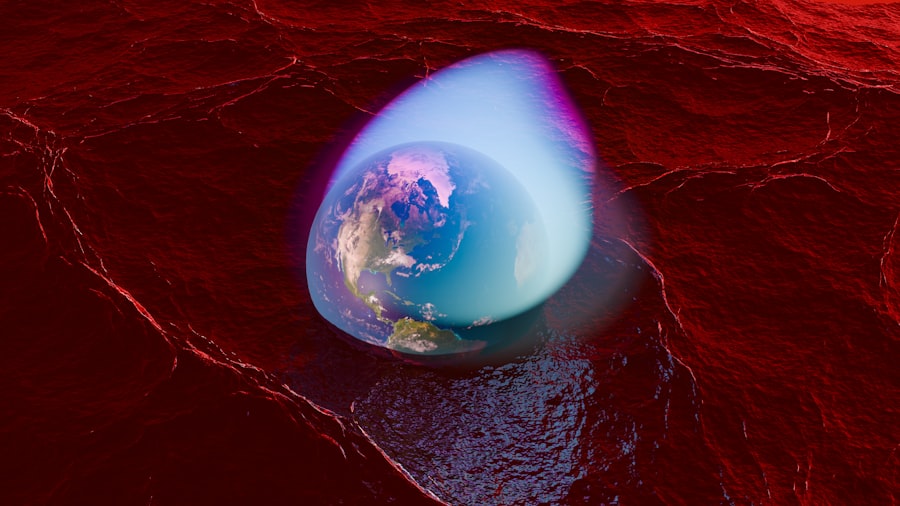In an era where humanity’s reach extends beyond the confines of Earth, the concept of a Planetary-Scale Keep Out Zone emerges as a critical framework for safeguarding celestial bodies within our solar system. This innovative idea seeks to establish designated areas that are off-limits to exploration and exploitation, ensuring the preservation of pristine environments and the protection of potential extraterrestrial life. As space exploration accelerates, the need for such protective measures becomes increasingly apparent, prompting discussions among scientists, policymakers, and ethicists alike.
The notion of a Keep Out Zone is not merely a precautionary measure; it represents a paradigm shift in how humanity interacts with the cosmos. As private companies and national space agencies embark on ambitious missions to explore and utilize resources from other planets and moons, the risk of contamination and irreversible damage to these celestial bodies looms large. The establishment of a Planetary-Scale Keep Out Zone could serve as a vital tool in maintaining the integrity of our solar system while fostering responsible exploration practices.
Key Takeaways
- Planetary-Scale Keep Out Zone is a proposed concept to protect our solar system from potential threats.
- The need for protection in our solar system arises from the increasing interest in space exploration and potential risks from human activities.
- Understanding the threats to our solar system includes natural phenomena, space debris, and potential contamination from Earth.
- The concept of Planetary-Scale Keep Out Zone involves establishing boundaries and regulations to protect celestial bodies and their environments.
- Implementing the Planetary-Scale Keep Out Zone requires international cooperation, governance, and the use of advanced technology for enforcement.
The Need for Protection in Our Solar System
The solar system is a vast and intricate tapestry of celestial bodies, each with its own unique characteristics and potential for scientific discovery. However, as humanity’s presence in space grows, so does the urgency to protect these environments from human interference. The need for protection stems from several factors, including the preservation of scientific integrity, the safeguarding of potential extraterrestrial ecosystems, and the ethical responsibility to avoid repeating historical mistakes made on Earth.
Scientific integrity is paramount in the study of celestial bodies. The introduction of Earth-based organisms or contaminants could skew research findings and compromise the authenticity of data collected from other planets. For instance, if microbial life from Earth were to contaminate Martian soil samples, it would be nearly impossible to determine whether any discovered life forms were indigenous to Mars or simply Earth life that had hitched a ride.
Thus, establishing protected zones is essential for ensuring that future generations can study these environments without the interference of human activity. Moreover, the potential for discovering extraterrestrial life adds another layer of urgency to the need for protection. The search for life beyond Earth has captivated scientists for decades, and many believe that certain moons, such as Europa or Enceladus, may harbor subsurface oceans capable of supporting life.
By designating Keep Out Zones around these celestial bodies, humanity can minimize the risk of contamination and preserve their natural state, allowing for more accurate assessments of their potential for hosting life.
Understanding the Threats to Our Solar System

The threats facing our solar system are multifaceted and complex. They range from environmental degradation caused by human activity to the potential for conflict over resources. As private companies and nations invest heavily in space exploration and resource extraction, the risk of damaging these celestial environments increases significantly.
The consequences of such actions could be dire, not only for the targeted bodies but also for humanity’s long-term relationship with space. One significant threat arises from the prospect of mining asteroids or other celestial bodies for valuable resources. While this endeavor holds great promise for addressing resource shortages on Earth, it also poses risks to the delicate balance of these environments.
The extraction process could lead to irreversible changes in surface conditions, potentially disrupting any existing ecosystems or geological features that hold scientific value. Furthermore, the potential for space debris generated by mining operations could pose hazards to other spacecraft and satellites operating in nearby orbits. Another pressing concern is the possibility of militarization in space.
As nations vie for dominance in space exploration and resource acquisition, tensions may escalate, leading to conflicts that could have catastrophic consequences. The establishment of a Planetary-Scale Keep Out Zone could serve as a deterrent against such militarization by promoting peaceful cooperation and shared responsibility among nations. By creating designated areas that are off-limits to exploitation, humanity can work towards a more harmonious relationship with the cosmos.
The Concept of Planetary-Scale Keep Out Zone
| Aspect | Details |
|---|---|
| Definition | The concept of planetary-scale keep out zone refers to the hypothetical area around a celestial body where human activities are restricted or prohibited in order to preserve the natural environment and prevent contamination. |
| Scope | This concept is often discussed in the context of space exploration and colonization of other planets, where the establishment of keep out zones may be necessary to protect potential extraterrestrial life and ecosystems. |
| Implementation | Implementing planetary-scale keep out zones would require international cooperation and the development of legal frameworks to define and enforce the boundaries of such zones. |
| Challenges | Challenges associated with the concept include defining the boundaries of keep out zones, addressing potential conflicts of interest, and ensuring compliance with regulations. |
The concept of a Planetary-Scale Keep Out Zone is rooted in the idea that certain areas within our solar system should be preserved for scientific research and exploration without human interference.
By establishing these protected areas, humanity can ensure that future generations have access to pristine environments for study and exploration.
The implementation of Keep Out Zones would require careful consideration of various factors, including scientific value, ecological significance, and cultural heritage. For instance, areas with high potential for discovering extraterrestrial life would be prioritized for protection, as would locations that hold historical or cultural significance for humanity’s understanding of space exploration. By taking a holistic approach to designating these zones, policymakers can create a framework that balances scientific inquiry with ethical considerations.
Moreover, the concept of a Planetary-Scale Keep Out Zone aligns with existing international treaties aimed at promoting peaceful exploration and preventing harmful activities in space. The Outer Space Treaty of 1967 established principles governing the use of outer space, including the prohibition of harmful contamination and the obligation to conduct activities in a manner that benefits all humankind. Building upon this foundation, a Keep Out Zone could serve as an extension of these principles, reinforcing the commitment to responsible stewardship of our solar system.
Implementing the Planetary-Scale Keep Out Zone
The implementation of a Planetary-Scale Keep Out Zone would necessitate collaboration among various stakeholders, including governments, international organizations, scientists, and private entities involved in space exploration. Establishing clear guidelines and protocols for designating and enforcing these zones will be crucial to their success. This collaborative approach would ensure that all voices are heard and that decisions are made based on scientific evidence and ethical considerations.
One potential model for implementation could involve creating an international governing body tasked with overseeing the designation and management of Keep Out Zones. This body could work in conjunction with existing organizations such as the United Nations Office for Outer Space Affairs (UNOOSA) to develop criteria for identifying vulnerable celestial bodies and establishing protective measures. By fostering international cooperation, this governing body could help mitigate conflicts over resource exploitation while promoting shared responsibility for preserving our solar system.
Additionally, public awareness campaigns will play a vital role in garnering support for the establishment of Keep Out Zones. Educating the public about the importance of protecting celestial environments and the potential consequences of unchecked exploration will be essential in building a consensus around this initiative. Engaging with communities interested in space exploration can help foster a sense of collective responsibility toward preserving these environments for future generations.
International Cooperation and Governance

International cooperation is paramount when it comes to establishing a Planetary-Scale Keep Out Zone. Given that space knows no borders, collaborative efforts among nations will be essential in creating a framework that is both effective and equitable. The complexities involved in governing outer space require a unified approach that transcends national interests and prioritizes the collective good.
One avenue for fostering international cooperation is through existing treaties and agreements that govern outer space activities. The Outer Space Treaty serves as a foundational document outlining principles such as non-appropriation of celestial bodies and the obligation to avoid harmful contamination. Building upon this framework, nations can engage in dialogue to develop specific guidelines for establishing Keep Out Zones around vulnerable celestial bodies.
This collaborative effort would not only enhance global governance but also promote transparency and accountability in space exploration.
By leveraging these platforms, countries can share best practices, address concerns about resource exploitation, and work towards consensus on establishing Keep Out Zones.
Such cooperation will be crucial in ensuring that all nations have a voice in shaping policies that impact our shared cosmic heritage.
The Role of Technology in Enforcing the Keep Out Zone
Technology will play a pivotal role in enforcing the Planetary-Scale Keep Out Zone effectively. As humanity ventures further into space, advancements in monitoring and surveillance technologies will be essential in ensuring compliance with established guidelines. These technologies can help detect unauthorized activities within designated zones and provide real-time data on environmental conditions.
One promising avenue is the use of satellite-based monitoring systems capable of tracking spacecraft movements and activities around protected celestial bodies. By employing advanced imaging techniques and data analytics, these systems can provide valuable insights into potential violations within Keep Out Zones. Additionally, artificial intelligence algorithms can analyze patterns of activity to identify anomalies or suspicious behavior that may warrant further investigation.
Moreover, developing autonomous drones or robotic systems capable of conducting inspections within Keep Out Zones could enhance enforcement efforts significantly. These systems could be deployed to monitor environmental conditions, assess potential contamination risks, and ensure compliance with established protocols. By leveraging technology in this manner, humanity can create a robust framework for protecting vulnerable celestial environments while minimizing human intervention.
Potential Challenges and Obstacles
While the establishment of a Planetary-Scale Keep Out Zone presents numerous benefits, it is not without its challenges and obstacles. One significant hurdle lies in achieving consensus among nations regarding which areas should be designated as protected zones. Differing national interests and priorities may complicate negotiations, leading to disagreements over which celestial bodies warrant protection.
Additionally, there may be resistance from private companies seeking to exploit resources from celestial bodies within proposed Keep Out Zones. The lucrative potential of asteroid mining or lunar resource extraction could create tensions between commercial interests and conservation efforts. Striking a balance between economic opportunities and environmental protection will require careful negotiation and collaboration among stakeholders.
Another challenge involves ensuring compliance with established guidelines once Keep Out Zones are implemented. Monitoring activities within these zones will necessitate significant investment in technology and infrastructure to detect violations effectively. Moreover, enforcing penalties for non-compliance may prove difficult given the complexities involved in international law and jurisdiction over outer space activities.
The Ethical and Legal Considerations
The establishment of a Planetary-Scale Keep Out Zone raises important ethical and legal considerations that must be addressed comprehensively. At its core lies the question of humanity’s responsibility toward preserving celestial environments for future generations. Ethical frameworks must guide decision-making processes surrounding resource exploitation and environmental protection to ensure that actions taken today do not compromise opportunities for future scientific discovery.
Legal considerations also play a crucial role in shaping policies related to Keep Out Zones. Existing international treaties provide a foundation upon which new agreements can be built; however, gaps remain regarding specific regulations governing protected areas in outer space. Developing clear legal frameworks will be essential in defining rights and responsibilities associated with Keep Out Zones while addressing potential conflicts between nations or commercial entities.
Furthermore, engaging diverse perspectives—ranging from scientists to ethicists—will enrich discussions surrounding ethical considerations related to planetary protection. By fostering inclusive dialogues that encompass various viewpoints, policymakers can develop comprehensive strategies that reflect shared values while promoting responsible stewardship of our solar system.
The Future of Planetary-Scale Keep Out Zone
Looking ahead, the future of a Planetary-Scale Keep Out Zone holds immense potential for shaping humanity’s relationship with outer space. As technological advancements continue to evolve alongside growing interest in space exploration, establishing protective measures will become increasingly vital in ensuring sustainable practices within our solar system. The successful implementation of Keep Out Zones could pave the way for more responsible exploration efforts while fostering international cooperation among nations engaged in space activities.
By prioritizing environmental protection alongside scientific inquiry, humanity can cultivate a culture that values preservation over exploitation—a shift that could redefine our approach to exploring new frontiers. Moreover, as public awareness surrounding planetary protection grows, there may be increased pressure on governments and private entities alike to adopt sustainable practices when venturing into outer space. This shift could lead to greater accountability within the industry while inspiring future generations to prioritize stewardship over short-term gains.
Safeguarding the Future of Our Solar System
In conclusion, establishing a Planetary-Scale Keep Out Zone represents an essential step toward safeguarding the future of our solar system. As humanity continues its journey into space exploration, it becomes imperative to prioritize environmental protection alongside scientific discovery. By designating protected areas around vulnerable celestial bodies, society can ensure that future generations inherit pristine environments free from human interference.
The challenges associated with implementing such zones are significant; however, they are not insurmountable when approached collaboratively through international cooperation and technological innovation. By fostering inclusive dialogues surrounding ethical considerations while leveraging advancements in monitoring technologies, humanity can create a robust framework for protecting our cosmic heritage. Ultimately, embracing the concept of a Planetary-Scale Keep Out Zone reflects humanity’s commitment to responsible stewardship—an acknowledgment that our actions today will shape not only our understanding of the universe but also our legacy within it.
As we stand on the precipice of new discoveries beyond Earth’s atmosphere, let us strive to safeguard these celestial wonders for generations yet unborn.
In the context of planetary scale keep out zones, the concept of safeguarding certain areas from human interference is crucial for preserving extraterrestrial environments. A related article that delves into the implications and strategies for establishing such zones can be found at
